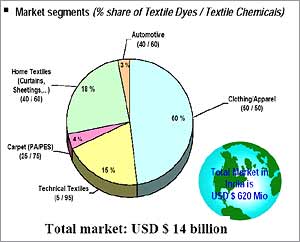To trace the history, textile dyes dates back almost
to the Bronze Age. Compare this to the 21st-century where Textile dyes
constitutes an important segment of the whole business of specialty
chemicals. Dyes that are used by the textile industry are now mostly
synthetic. They are mostly derived from two sources namely, coal tar and
petroleum-based intermediates. These dyes are marketed as powders,
granules, pastes or liquid dispersions. The concentrations of active
ingredients typically ranges from 20 to 80 percent. The textile dye
segment is characterized by new dyes. These new dyes are regularly
developed for meeting the demands of new technology, new kinds of
fabrics, detergents, advances in dyeing machineriest, along with
overcoming the serious environmental concerns posed by some existing
dyes. Another important factor is the fact that almost all the products
are subjected to seasonal demand and variation. Industrial textiles Dyes
must rise up to meet all these new and specific technical requirements.
With the fast changing of the product profile of the textile industry,
from high-cost cotton textiles to the durable and versatile synthetic
fibers, the pattern of consumption of these dyes is also going through
rapid changes. Now a days, Polyesters account for a major part of dye
consumption. Accordingly, disperse dyes, that is used in Polyesters, are
also projected to grow at a faster rate.

